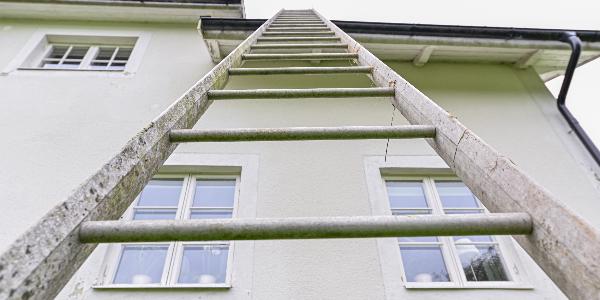The First Step is the Scariest

By The RIDGEPRO.
You may use it every day, but don't underestimate the dangers of climbing up a ladder. Look to these tips to keep you safe.
Ladder safety tips and techniques
It’s pretty obvious to all of us in the roofing and construction trades that ladders are often the source of injuries on the job. The ladder is generally not to blame; it’s a worker who wasn’t properly trained or just took his or her eye off the ball for a moment. That’s all it takes and the next thing you know, someone is calling 9-1-1 for an ambulance to rush to the jobsite for a fall related injury.
As we enter the season of ghosts, zombies and scary stories take the time to inspect all ladders and review ladder safety with each crew. OSHA and ANSI both have standards for ladder safety that need to be followed. Here are a few points to remember:
- Ladder selection comes first and that means matching the right tool to the right job. On professional roofing/construction jobs, a household or medium duty ladder (Types III or II) just won’t cut it. Roofing or construction jobs call for a Type I ladder (grade A) that will support 250 pounds or a Type IA (Grade 1A) that will support up to 300 pounds. (No cheating on the weight – don’t forget to add in a worker’s clothing, PPE and any tools or equipment.)
- Ladders must be rigorously maintained. Inspect each one often for dirt and debris, particularly in or around the mechanism of an extension section or around the feet of any ladder.
- Before they enter the worksite, make sure all crew members and supervisors have received the proper training and understand their roles. Be sure to stress that each member of the crew has the power and the duty to point out any deficiencies or hazards.
- At the worksite, a job supervisor or safety manager must be charged with identifying potential hazards including mud or a soft footing, tree branches and wires. Don’t forget to look for doors that open outwards. No one, not the homeowner or your workers needs a scary surprise.
- Ladder placement and angle are critical parts of jobsite safety. Standards say that the ladder angle from the ground to the structure should have a ratio of 1:4, that is, the ladder’s base must be one foot out from the structure for every four feet in height. When placed properly, this should result in a ladder angle of 75 degrees. Remember: the ladder should extend three feet above any structure such as a gutter or roof edge.
Stepping up safely
Now it’s time to climb the carefully positioned ladder. Workers are wearing fall protection gear and helmets and have been trained in their use, right? It’s time to put down the cell phone and concentrate. Face the ladder for the climb. This is no time to be turning around to shout something back to those on the ground.
Two hands + two feet = four possible points of contact. Three of these should be in contact with the ladder at all times. You choose. Climb hand over hand carefully. Keep your body centered between the rails.
It is recommended that heavy items be hoisted directly to the roof because carrying anything while climbing a ladder increases the danger level. Even commonly used tools and materials such as a 40 pound solar panel add to the weight put on the ladder. It’s easy to forget that a sheet of plywood weighs approximately 80 pounds and a bundle of shingles weighs between 75 and 100 pounds. If the ladder is rated for only 250 pounds, a worker could be well over the limit with either of those items in hand. Consider stepping up to a IAA Grade 1AA heavy duty ladder that’s rated for 375 pounds.
Don’t mask the dangers
Ladders are so common in the roofing, solar and construction industries that workers tend to overlook the risks involved in each and every climb. The ability to work high above the ground is a skill to be proud of. Rooftop safety lies in achieving a healthy balance between fear and familiarity. Respect the height and never worry about taking that first step up the ladder.
Learn more about The RIDGEPRO® in their Coffee Shop Directory or visit www.theridgepro.com.






















Comments
Leave a Reply
Have an account? Login to leave a comment!
Sign In